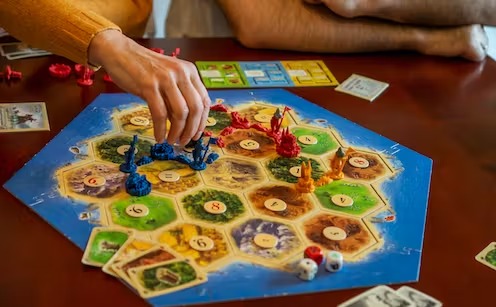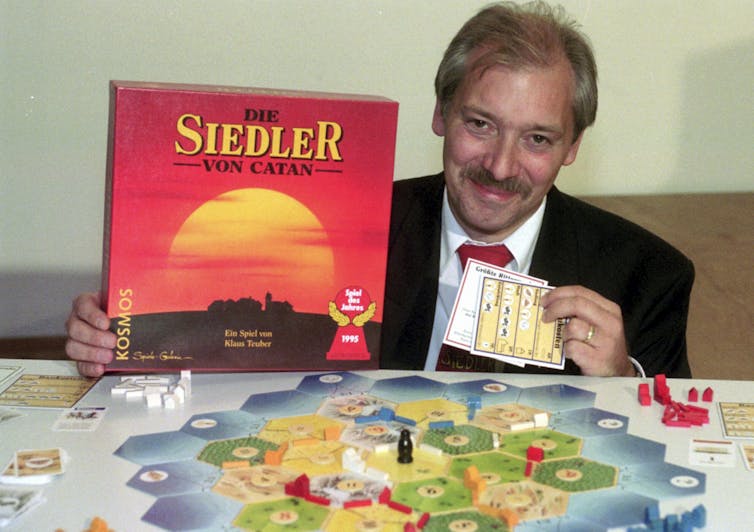The death of Klaus Teuber, creator of popular board game Catan, marked the passing of a board game giant.
Teuber died on April 1, 2023, after a brief illness. The German-born dental technician-turned-game designer invented the game, originally called Settlers of Catan, in 1995 while managing a dental lab. That same year Catan won one of board gaming’s most prestigious awards, the German Spiel des Jahres.
He once recalled in an interview how the idea began to percolate in 1963 as an 11-year-old in post-war Germany. According to Teuber, Catan was inspired by tales of Viking exploration, and it places players together on a remote island, where they must competitively collect and cultivate territory through resource extraction, trade and expansion by building roads and settlement.
Since 1995, the game has sold more than 40 million copies and has been translated into more than 40 languages. It fundamentally changed the board game industry, with dozens of spinoffs and new editions, including electronic versions.
In 2010, The Washington Post named Settlers of Catan the “board game of our time,” and this is true in many regards. For example, during the early months of the pandemic, Catan experienced a revival as sales skyrocketed.
Unfortunately, however, the most potent and painful relationship between Catan and our world today remains largely unexamined.
Settler colonialism
In interviews, Teuber said he started creating games in the 1980s to help deal with the stress of his dental career. “I developed games to escape,” he said. “This was my own world I created.” The Settlers of Catan — renamed Catan in 2015 — wasn’t really Teuber’s own world, it was a playable version of the American dream.
Klaus Teuber presents his game The Settlers of Catan in September 1995, in Frankfurt, Germany. Teuber created of the hugely popular board game in which players compete to build settlements on a fictional island. (AP Photo/Bernd Kammerer, File)
Ultimately, through a set of game mechanics that motivates resource extraction in the name of settling a supposed empty land, the connection between the in-game narrative and the political histories of North America and other parts of the world is clear. As historian Lorenzo Veracini says, “the Settlers of Catan is really about settler colonialism.”
The success of Catan also codified a certain kind of game play that has similarly proliferated worldwide, one that’s invested in the specific historical, economic and political factors of settler colonialism.
This gaming rhetoric quickly began to shape the game mechanics and narrative strategies of not only European games but also global tabletop gaming culture.
The Settlers of Catan was not the first time a board game touched on colonial or imperialist discourses. Risk, invented by French film director Albert Lamorisse and originally released in 1957, is an early example of how discourses of conquest emerged in tabletop games.
Here, players conquer their enemies’ territories by building an army, moving their troops in and engaging in battle.
However, because players in Catan explicitly take on the roles of settlers, this particular board game’s engagement in the rhetoric of settler colonialism set new precedents. And unfortunately, games that incorporate colonial histories and strategies into their narratives or game mechanic normalize these discourses through their status as a popular pastime.
Risk, originally released in 1957, is an early example of how discourses of conquest emerged in tabletop games. (Shutterstock)
Decolonizing gameplay
Since 1995, board games have continued to include themes of settler colonialism, with several games published globally that even concretely engage Indigenous presence during and after their first contact with colonial powers.
In these games, Indigenous identity, history, culture and sovereignty emerge as essential elements of world-building and game mechanics. In the game Neta-Tanka, for example, the Frostrivers tribe dwells along the Great Frozen River in harmony with nature, obeying the laws of the Four Elders and in turn, guided by the most venerable of the Elders, the Neta-Tanka.
However, these features often merge or misrepresent Indigenous cultures and traditions in problematic ways. In the board game Manitoba, players become clan leaders of the Cree tribe and try to become the chieftain of them all. But the iconography associated with this already problematic playable version of Indigenous resource management and spiritual guidance are totem poles, which are not part of the cultures of Indigenous Peoples in Manitoba.
These games seek to create a compelling story at the expense of Indigenous traditional knowledge and contemporary lived experience, ignoring the contribution of Indigenous voices through consultation while missing opportunities to engage concretely with issues that impact global Indigenous Peoples.
At the same time, a small group of Indigenous designers and board game enthusiasts have begun to develop counter-discourses through board game development. Board game designer and Assistant Professor of Interactive Media Greg Loring-Albright has shown with First Nations of Catan that it is possible to modify and decolonize gameplay by drawing attention to issues of Indigenous sovereignty.
Another excellent example of this is Sínulkhay and Ladders by Ta7talíya Michelle Nahanee, a Squamish decolonizing facilitator, creative director and Indigenous changemaker.
The design is based on Snakes and Ladders, but its goal is to teach players how to decolonize their actions and decision-making processes.
Similarly, the recent successes of the role-playing game Coyote and Crow, by game designer Connor Alexander, and the board game Nunami, by Inuk graphic designer Thomassie Mangiok, demonstrate that board games can make valuable contributions to Indigenous self-representation in popular culture.



 The pandemic is still disrupting young people’s careers
The pandemic is still disrupting young people’s careers  Canada’s local food system faces major roadblocks without urgent policy changes
Canada’s local food system faces major roadblocks without urgent policy changes  Can your cat recognise you by scent? New study shows it’s likely
Can your cat recognise you by scent? New study shows it’s likely  Fed Near Neutral Signals Caution Ahead, Shifting Focus to Fixed Income in 2026
Fed Near Neutral Signals Caution Ahead, Shifting Focus to Fixed Income in 2026  Stuck in a creativity slump at work? Here are some surprising ways to get your spark back
Stuck in a creativity slump at work? Here are some surprising ways to get your spark back  Robinhood Expands Sports Event Contracts With Player Performance Wagers
Robinhood Expands Sports Event Contracts With Player Performance Wagers  Yes, government influences wages – but not just in the way you might think
Yes, government influences wages – but not just in the way you might think  Columbia Student Mahmoud Khalil Fights Arrest as Deportation Case Moves to New Jersey
Columbia Student Mahmoud Khalil Fights Arrest as Deportation Case Moves to New Jersey  The American mass exodus to Canada amid Trump 2.0 has yet to materialize
The American mass exodus to Canada amid Trump 2.0 has yet to materialize  Asian Fund Managers Turn More Optimistic on Growth but Curb Equity Return Expectations: BofA Survey
Asian Fund Managers Turn More Optimistic on Growth but Curb Equity Return Expectations: BofA Survey 


































